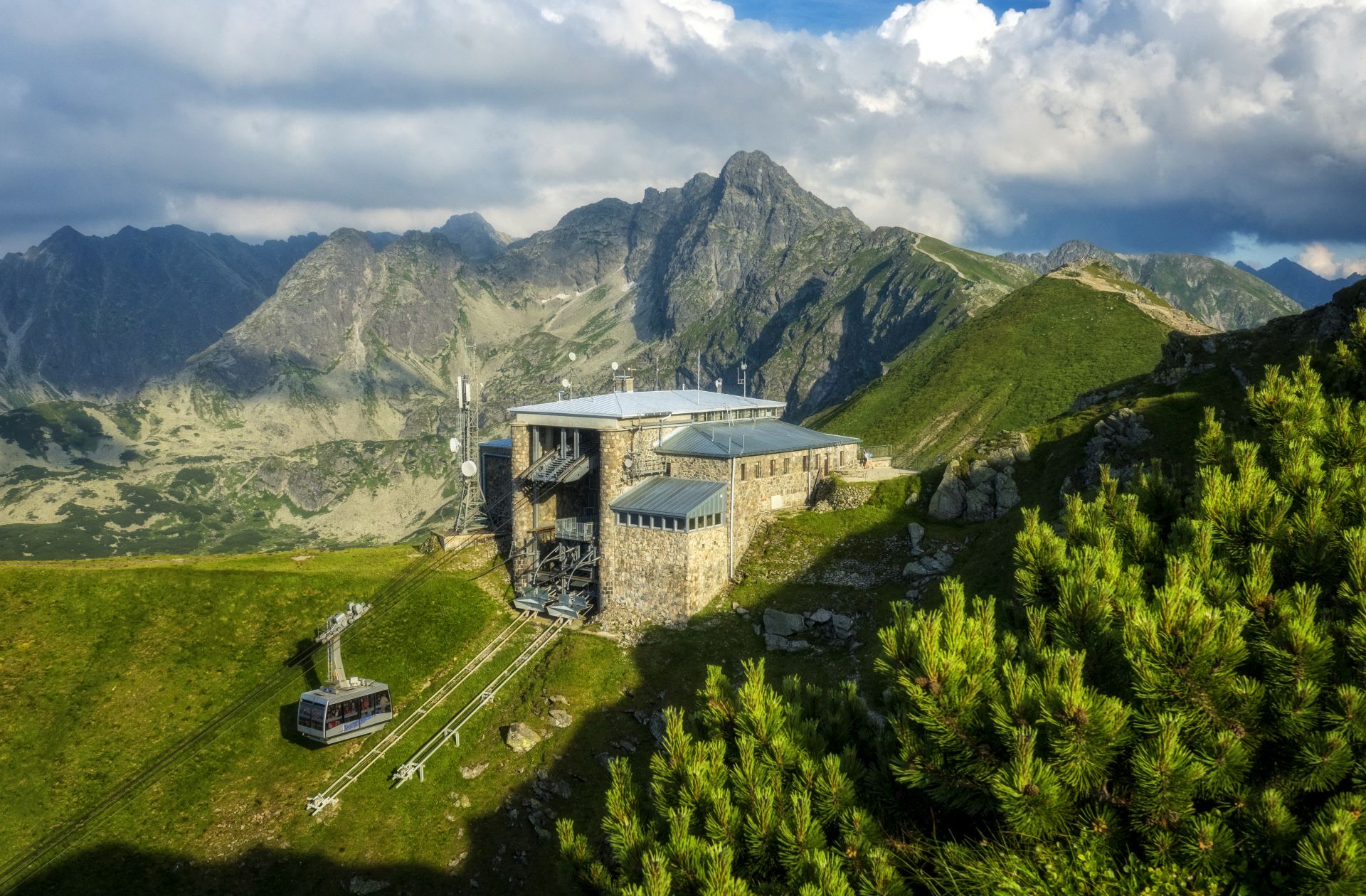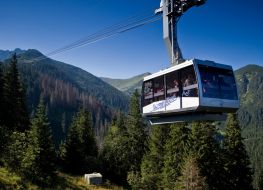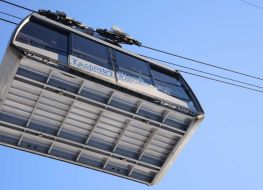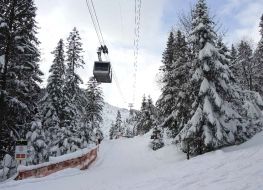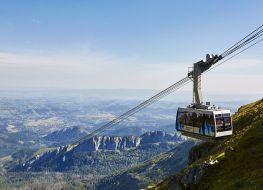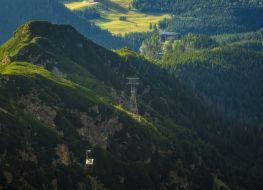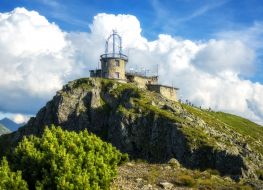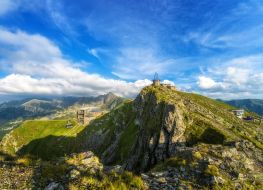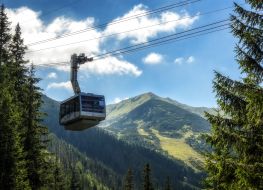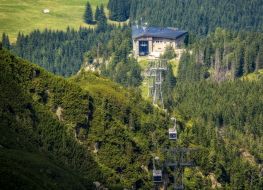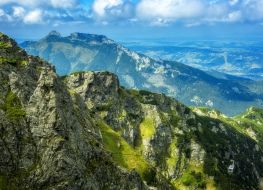A
cable railway from Kuźnice to the top of Kasprowy Wierch, the whole
runs through the area of the Tatra National Park. The
railway operator is Polskie Koleje Liniowe S.A. The route to Kasprowy
Wierch, though it is 4291,59 meters long, it takes only a dozen
minutes or so, thanks to the only high-altitude ropeway in Poland.
The wagons carry only 60 people at a time, and the trip by the wagon
suspended over the Tatra valleys stays in your memory forever, and
it’s full of exciting experiences and amazing views. The journey
ends at 1959 meters above sea level in the upper station of the
railway, just 26 m below the top of Kasprowy Wierch. The upper
cableway station and the Meteorological Observatory are the
highest-located buildings in Poland.
Kasprowy
Wierch is one of the most recognizable mountains in the Tatras. This
peak, located on the border of the High and West Tatras, offers
unforgettable landscapes that can be admired endlessly. From the
height of almost 2,000 m above sea level, there is a magnificent
panorama of the gentler hills of Czerwone Wierchy and of the much
sharper peaks of the High Tatras (including Świnica and Orla Perć).
You can also see Giewont, with a cross and legendary knights sleeping
somewhere in the rocks; the favorite destination for many tourist
trips.
From
Kasprowy, you can also admire the Slovak part of the mountains, and
even descend into the Ticha Valley (Cicha Liptowska).
There are many tourist routes crossed here that lead to the valleys
or the surrounding peaks. Tourists can eat something good in the
restaurant and admire the local meteorological observatory.
At
the foot of Kasprowy, there are two cirques: Gąsienicowy and
Goryczkowy, descending with gentle meadows towards the Murowaniec
hostel and huts at the Hala Kondratowa.
You
can relax there, drink warm tea and bask in the sun, watching the
cloudy music and small figures moving around them.
History
The
initiator of the railway construction was the then-president of the
Polish Ski Association and Deputy Minister of Transport Eng.
Aleksander Bobkowski. Field studies and measurements to determine the
course of the railway route were initiated by the Central Office of
Studies and Projects of the Polish State Railways commissioned by the
Ministry of Transport in the spring of 1934. The
decision to build was made in July 1935. The investor was a specially
formed company (ltd.) under the name "Society for Construction
and Operation of the Cable Car Zakopane (Kuźnice) - Kasprowy Wierch"
with headquarters in Warsaw. The shareholders were: Polish State
Railways, Tourism Support League, Polish Travel Office "Orbis",
Society for the Promotion of Skiing and the Gdansk Shipyard.
On
July 24, 1935, the construction management was established, based in
Zakopane Kuźnice. The construction manager was Eng. M. Stadnicki,
deputy engineer B. Lange. A detailed schedule was determined by the
record-breaking short construction time of 7 months for such an
investment. Since no company was able to accept such conditions, it
was decided that the construction of an economic system would be
conducted. The number of the crew members, which initially amounted
to around 600 people, in the last two months was increased to 1000.
Workers were recruited not only from the Podhale region, but also
from Nowy Sącz, Cracow, Tarnów and even from the Vilnius region.
Employment of skilled stonemasons from Brasławia and weavers and
carpenters from Polesie. works on the site began on August 1, 1935.
The
construction of the railway caused a lively social discussion, mainly
environmental protection activists protested against it, though in
addition to the State Council for Nature Conservation, there were
also 94 societies and scientific and tourist institutions.
In
response to the beginning of the construction, the whole of the
then-National Council for Nature Protection, including the head of
the Committee for Nature Conservation in Krakow - Prof. Władysław
Szafer - resigned. Their resignation was notaccepted. The
construction of the train lines led to other investments: the
observatory on Kasprowy Wierch, the so-called ceprostrad (from the
Morskie Oko to Szpiglasowa Pass), the hotel on Kalatówki.
It
was the first investment of this type in Poland, and the sixth in the
world. It consists of two sections that are independent of each
other:from
Kuźnice to Myślenice Turna (launched on February 26, 1936, a test
run of one wagon on this section was made by a Bleichert fitter on
February 17, 1936) and from Myślenice Turnia to Kasprowy Wierch. On
each stretch, two wagons were suspended on one line - one
moving up and the other down. The machines were built by the shipyard
in Gdansk, while the ropes - the factory in Sosnowiec. The investment
was created and constructed at a record pace of 7 months.The
work was completed on February 29, 1936, the first passengers entered
Kasprowy Wierch on March 15, 1936, after 227 days from the
commencement of construction.For
importing materials, a road was built for Myślenice Turnia, where
the trans-shipment of cars into horse-drawn Hutsul carts took place,
which then transported building materials to Hala Gąsienicowa.
Materials (cement, rope, water) were transported on the backs of
workers from there.The
works were carried out for 2-3 shifts (16 hours a day). The buildings
of the lower station in Kuźnice, the central one at Myślenice
Turnia and the last one at the top of Kasprowy Wierch were designed
by Anna and Aleksander Kodelski.The
cable railway to Kasprowy was a prestigious propaganda investment of
the Second Republic of Poland and presented the then innovative
Polish technology and architecture.The
cost of building the railway amounted to over PLN 3.5 million and it
was paid off before 1939.At
the upper station, in 1936, a Polish emblem in the Art Deco style
(preserved until today) was placed. The same year, architect
Aleksander Kodelski, in order to celebrate the construction of the
railway, created a modernist villa in Warsaw (currently historic, ul.
Czarnieckiego 53), which is a copy of the lower station of the
railway to Kasprowy Wierch.In
1961, the railway was modernized by replacing the wagons with new
ones. In 1985, on the occasion of the jubilee of the 40th anniversary
of the existence of the cableway to Kasprowy Wierch, a film
commemorating its construction history was created, the film "Towards
the Tatra Peaks" was made by Wytwórnia Filmów Dokumentalnych.
On
May 6, 2007, the last course of the oldest cableway in Europe took
place before its thorough renovation. Plans to expand the railway and
to increase its capacity, analogous to the plans for the construction
of the railway itself in 1934, triggered protests of scientists
(including naturalists), environmentalists and the opposition of part
of society.For
more than 70 years, the railway has carried over 38 million
passengers. As agreed, the modernization was completed on December
15, 2007.
When
you are in Zakopane and you don’t
enter Kasprowy, it's like being at the seaside and not getting your
feet wet.
Are you on vacation, vacation, meeting in the capital of the Polish
Tatra Mountains? You can’t miss this opportunity - go up!
Contact
Kuźnice
14 st.
34-500
Zakopane
telephone
+48 18 20 144 10
e-mail:
bok@pkl.pl
website:
www.pkl.pl/kasprowy-wierch
 Bardzo dobra
Bardzo dobra





